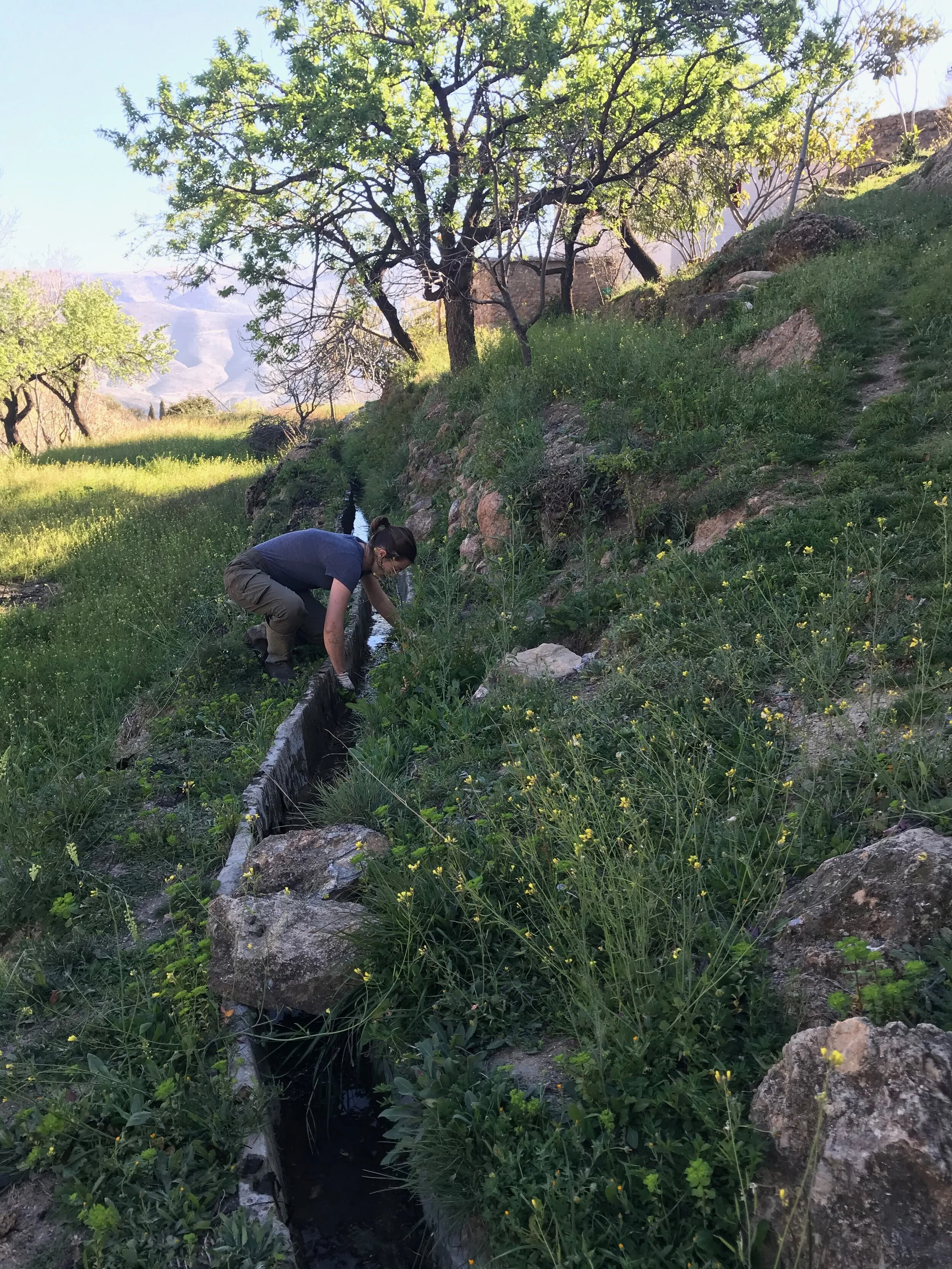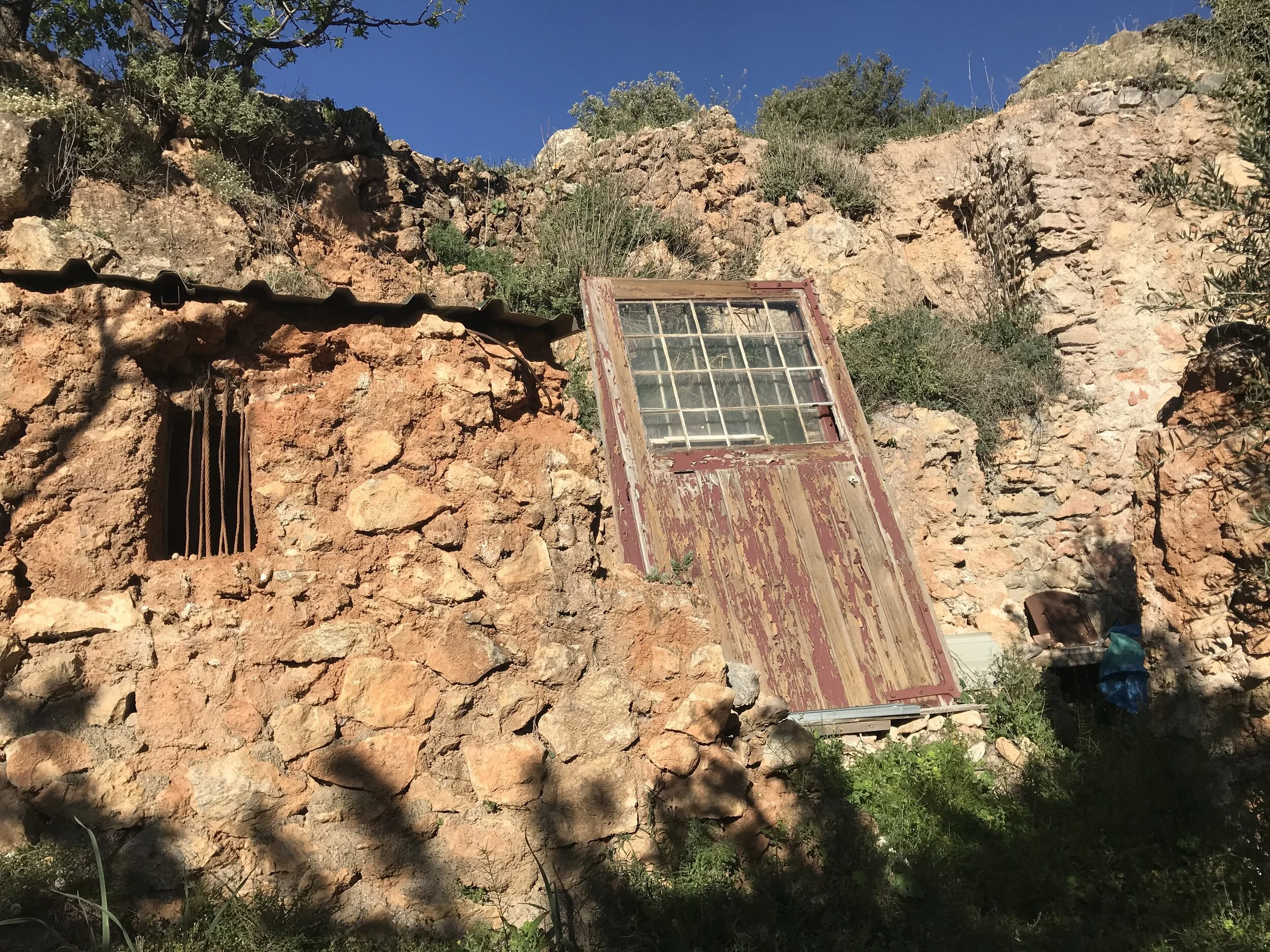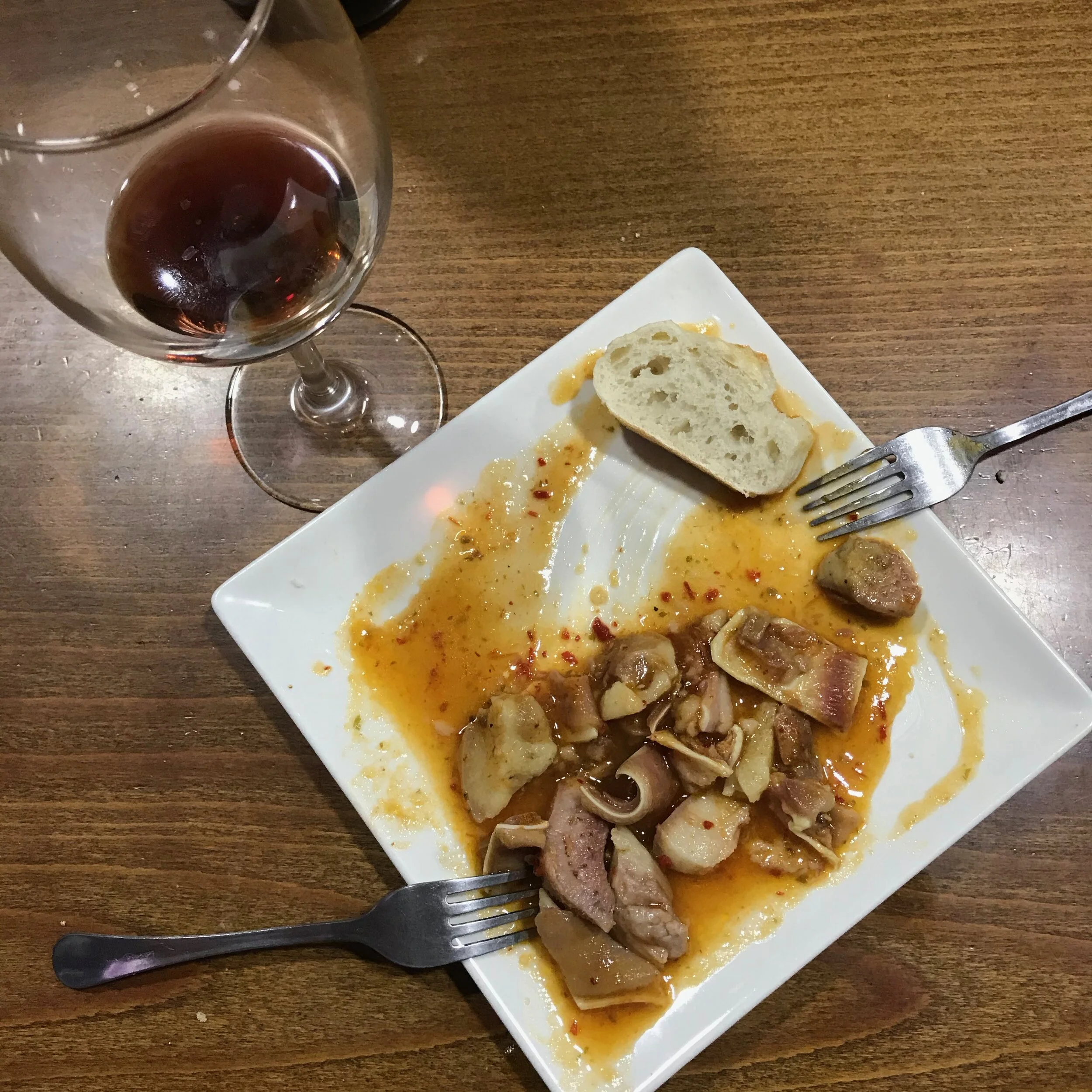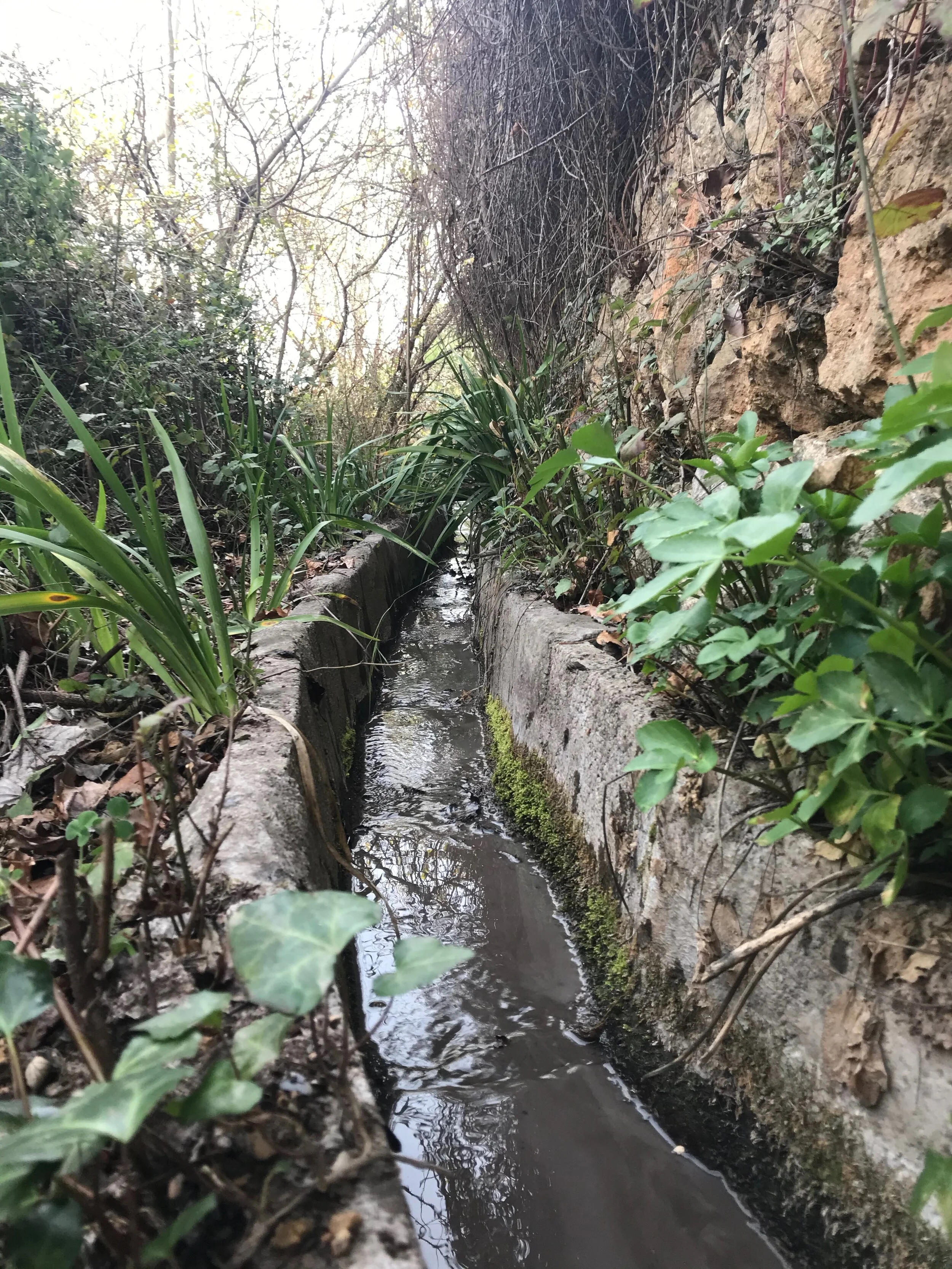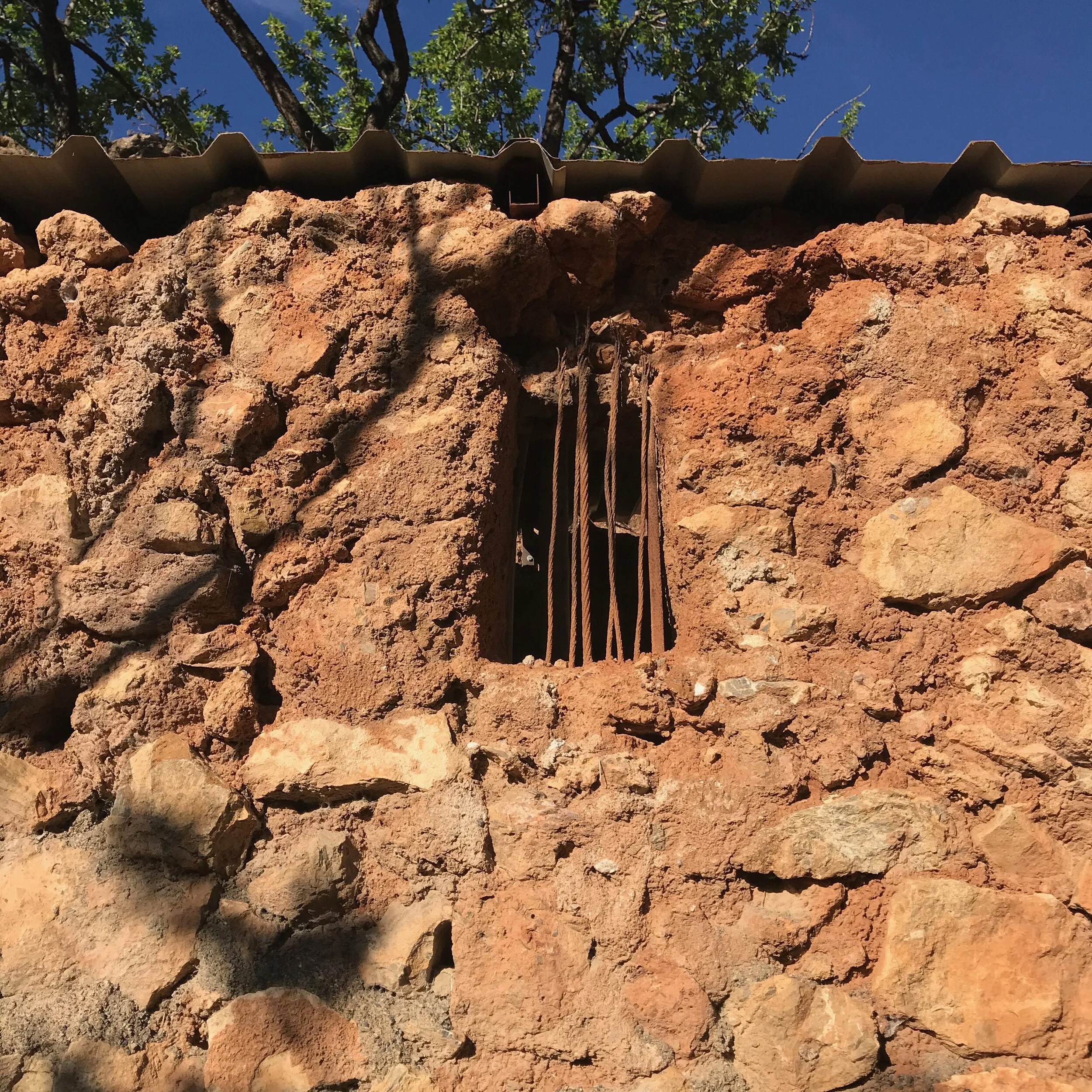To The Mountains, Part II: Pig Paradise
On our second day we explore more of the property at the mill. Jodi leads us along one of the canals which flows past the mill, through abandoned groves and overgrown thickets. The path takes us by a ruin, exteriors built around where rain and wind have carved small caves into the mountainside. Only some crumbling walls remain. The first of these, 20 or 30 yards from the mill, would have been storage, a silo-like cistern built into the rock behind it used for holding extra grain. It’s been repurposed for storage, a makeshift lean-to filled with trimmed almond and olive branches for burning. Weeds grow inside anywhere they can find light and a little water. Some old barn doors 12 feet high are leaned in one corner flaking red paint onto the parched dirt floor.
Jodi directs our attention to something large, about chest high, among the ruins. It’s wrapped in blue plastic sheeting so that the only thing visible is an iron exhaust pipe jutting out from the top. She moves some of the plastic aside, revealing the sun-cracked gesso and dark opening of her wood-fired oven. She began building it a couple of season’s ago, an industry-pro who can’t imagine her winter’s “off” without something to keep her hands busy. Nor without good bread.
She slides her hand over the smooth brick, envisioning her dream (one of the dozens we’ll hear over the coming week, all of which I’ve no doubt she’ll accomplish): a baking studio in the mountains, host to classes and culinary trips and a gateway to a not-so-distant past of communal living around the village hearth. And this mix of tradition and modernity is reflected in her vision for the space: a glass and steel exterior filling the gaps in the old crumbling walls; flour replacing the red dust that now fills the space; and the smell of toasted grains and fresh-baked breads once again wafting down the valley from El Molino. But for now, there’s only the oven. And the dream, at once poetic and incongruous, of bringing bread back to a ruin.
We climb out of the ruin (and Jodi’s brain), making our way beyond the mill’s terraces and onto a narrow path which clings to the face of this small bit of mountain. She’s leading us towards the nacimiento, a natural mountain spring which was once this canal’s water source. The deeper we go the more the forest closes in; its air, peaty and wet, lays heavily around us. Through a tangle of vines at our right we see the forest floor for the first time, about 15 or 20 feet below us. Back here, near the water (when there is water), the aspens grow tall and their silvery leaves form a thick shimmering canopy. Protected from the sun, the undergrowth spreads wild and impassable, dense with reeds and thorns except for where animals have trampled their meandering paths. Muddy and alive, this new world rises to meet us as we push ever deeper into the thicket, until finally, about 200 yards from the mill, we hit the bottom and our course merges with those animal paths.
We stand now at the bottom of the gulch. Nearby is an old picnicking area where a large millstone serves as an improvised table. It seems impossible that someone could move it here, yet there it lays, a starburst of purple allium blossoms growing out the hole in its center. Just ahead, we can see where the section of canal we’ve been following begins; or rather, where the upper section of canal has crumbled leaving this lower part to wallow in a bog-y pile of mud. Unconstrained by the canal’s concrete, what little water there is drifts and pools in the mud. Looking more closely, we realize these little pools are actually rather large hoof prints and beds where wild boars have been finding some respite from the winter sun. You can smell them, a dirty and wild funk. In a word, piggish.
The Ruined Mill, Seen From Above
Just up from the mouth of the canal another ruin towers above us, its hard-edged brown distinct from the greenery around us. Two buildings this time, both much larger than the last. The original mill, built long before the building we’re staying in now. Our path winds up from the mud and alongside the crumbling stone. Most of the walls have collapsed, but some remain. Even a precarious archway still stands, its heavy stones resistant to time and gravity.
I can’t resist exploring and crawl over a half wall and into the overgrown interior. Jodi and Breezy continue up the path away from the ruin. Inside, old equipment still lays where it was left decades ago. And though rotting or rusted beyond repair, I recognize some from what I’ve seen at El Molino: concrete flour troughs, millstones, and a water wheel on a split wooden axel.
By now I’ve lost sight of either Jodi or Breezy, and have gotten far enough away so that I can’t hear them either. Air moves through the wall-less space, rustling the weeds. And then all goes still. The sort of disquieting country-silence you forget can exist anywhere anymore. A twig cracks somewhere on the path behind me. In the silence, it seems like lightning. Then, Jodi’s scream and, is that thunder? The earth seems to vibrate as I clamber up onto a low wall to get a view of the path. I see Breezy followed by Jodi breathlessly scrambling down the path. “Boar! It was a wild boar!”
I meet them back on the path where Jodi leans on the ruins hand on her heart. Finally, between breaths she manages, “It was sleeping. I must have startled it. And then. All I saw were its hairy black hams running into the woods.” We hurry back along the canal path listening for the sound of trotters in mud behind us and laughing all the way.
Following our brush with porcine death we need a drink. To be fair, Spanish jabalí are huge, 150-400 pounds on average (sometimes as much as 700), and armored with 10-inch long tusks. We’d also heard that they’re extremely territorial and won’t back down from a fight. Lucky for us, we’d found one that did; the only one evidently. Which means we’re all still alive and able to head down to Lola’s to share our story and drink some local wine.
As a rule, the Spanish love their pigs. It was predestined really. Docile and industrious, pigs (along with goats) were the logical choice for domestication in a mountainous country, the far-flung regions of which have too little water (Extramaduras), too much water (Galicia), and not much grassy flatland (everywhere). You don’t need pasture, really. They’ll root around for themselves in whatever space you give them (lucky for you if you live in Extramaduras and that space is all Black Acorn forest, the home of Iberico). And if you don’t have land just throw them your rotting scraps; the pig is by and large the most efficient animal at turning rock-hard crusts and potato peels into fat-streaked bacon and hams.
Yes, the Spanish love pigs and, logistics aside, as anyone whose touched fatty Serrano to their lips or wiped smoky chorizo oil from their chin will tell you, they love eating them even more. By the time of our run in with the wild boar (genetically, only a distant cousin), we’d tried most of the common pig bits served in Spain, as well as a few of the lesser delicacies: Jamón (Iberico and Serrano) of course, loin, shoulder, sausages (Chorizo, Soprasada, Buttifarra, Longaniza), cheeks, ears, hocks.
But tonight, following our run in with a wild hog, this calls for something special. Lola seems to know it too. Communicating in alternating turns with her Google Translate app, we relay the story of our not so heroic adventure. In response, between fits of laughter, she puts her two index fingers up to her mouth, pantomiming a charging boar and its tusks. “Solo te derribaría,” she says. It would only knock you over. Sure it would.
The men playing dominoes call for another plate of something or other. Lola heads to the kitchen and returns with a steaming plate and basket of bread. It smells incredible, rich and fatty, with the slight tingle of a touch of vinegar. Whatever it is, the men quickly devour it between sips of sherry and beer, spreading it on the bread or eating it straight from a toothpick. Lola sees our envious faces and asks if we want some. “¡Claro que si!” Of Course!
She brings the plate and sets it proudly on our table. Careta de Cerdo. Pig’s Face. “Oh, like head cheese,” I ask. “No,” she responds tersely. “Solo la careta. No carne.” Only the face. No meat. We look down at the plate. Sure enough, there lie small chunks of skin and fat quivering in a glistening red sauce, no flesh in sight. A few chiles float in the fat that pools along the sides. It smells animal in the way only pork can, funky and almost sweet. Sweet from garlic too. Enthusiastically, I spear a piece with a toothpick and take a bite. It’s giving and sticky like candy, a porky toffee that clings to my teeth (don’t eat careta with crowns!). Slight chile spice and wine vinegar cut through some of the intense fat, a tastebud’s warm knife through butter. I rub my tongue over my teeth, savoring every carnal bit; what I can’t manage to unstick slowly dissolves on its own. I wash it down with a swig of beer and dive in for more.
Before long, the plate is gone, another pleasant pig memory to file alongside our run in with the jabalí. We’ve had our revenge and it is, in fact, quite sweet. And sticky.
Lola’s Careta de Cerdo
Braised Pig Face in Sauce
Serves 12 as a Tapa
Ingredients
1 pig face, including ears and snout, meat removed and saved for another use
2 bay leaves
6 black peppercorns
1 head of garlic, unpeeled and any loose skins removed
2 t salt, plus more to taste
2 tablespoons olive oil
2 onions, roughly chopped
2 Spanish choriceros, or 2 dried New Mexico or ancho chiles, seeds removed
4 tomatoes, coarsely chopped, or 1 cup tomato puree
8-10 guindilla chiles or peperoncini, seeds removed
2 whole sprigs fresh parsley
1 T white wine vinegar
Bread, to serve
Method
Add the pig’s face, bay leaves, peppercorns, head of garlic, and salt to a stock pot or pressure cooker and cover with water. Bring to a boil (or up to pressure), then reduce the heat and simmer until the face is tender, about 1 1/2 hours (or 40 minutes in the pressure cooker). Remove the face and head of garlic and reserve both until cool enough to handle.
Meanwhile, in a large skillet, heat the olive oil over medium-high heat. Add the onion and fry, stirring frequently, for 3-4 minutes until it begins to brown on the edges. Squeeze the reserved garlic out of its skins and add to the onions along with the dried chiles. Sauté for a minute or two, until toasty and aromatic. Now add in the tomatoes, guindillas (or peperoncini), and parsley, stirring to scrape up any brown bits that have stuck to the pan. Reduce the heat to medium, and cook for about five minutes, until the tomatoes have broken down and the flavors have melded.
Remove the contents of the skillet to a blender or food processor add in the vinegar and blend until very smooth and homogenous. The sauce should be relatively thin, so add water a tablespoon at a time until you reach the desired consistency. Return to the pan.
Chop or tear the cooled face into bite size pieces and add to the sauce. Rewarm over low heat and check for seasoning.
Serve, garnished with parsley, alongside some good toasted bread and some additional guindillas or peperoncini.

